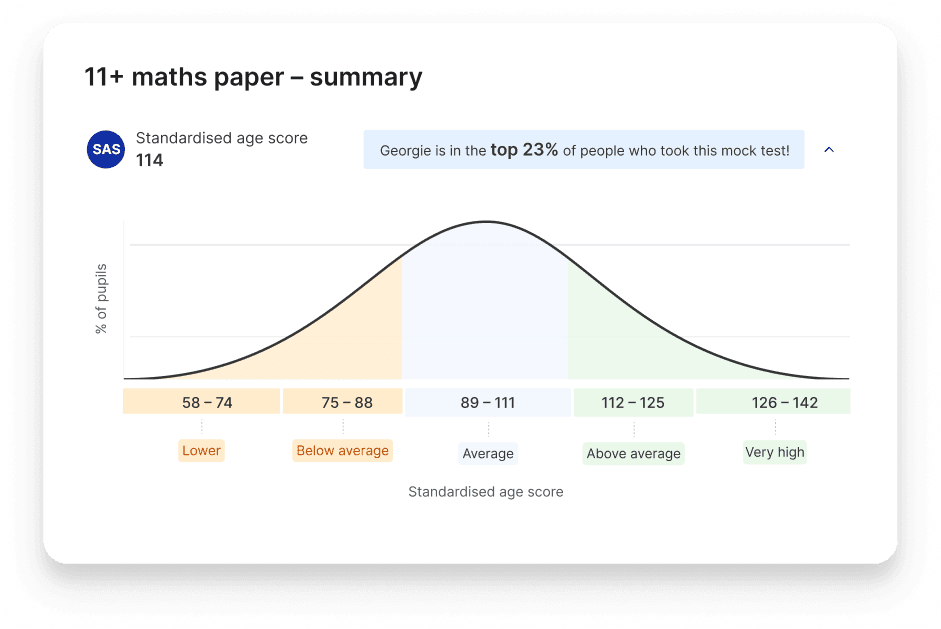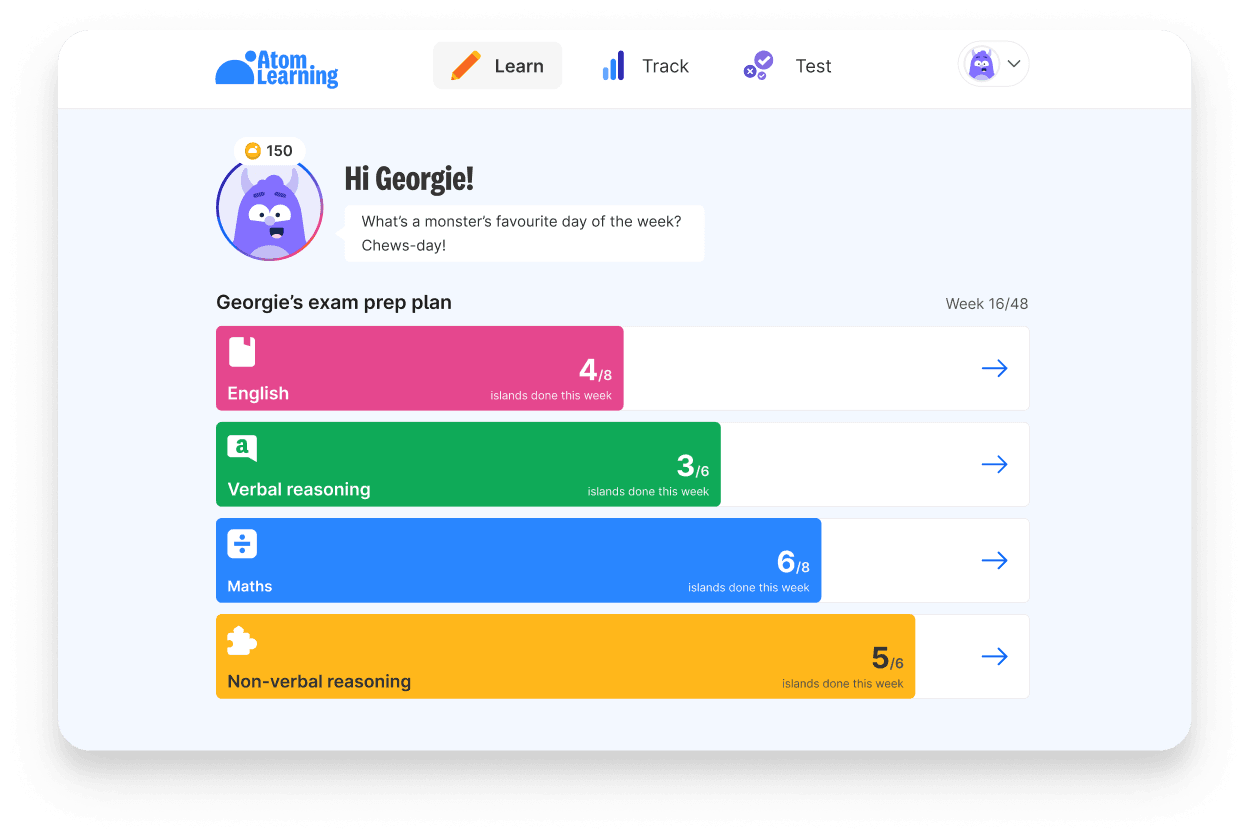Is your child applying for 11 plus entry to a grammar school or a selective independent school? Most 11 plus exams include a maths test.
Keep reading to find out everything you need to know about 11 plus maths. In this article, we'll cover:
The key topics your child needs to know
The types of maths questions used by major exam boards
How your child can revise and prepare effectively
Plus, sign up for Atom's free 11+ course and get a full-length 11+ maths practice paper!
When are 11 plus maths exams?
If your child is applying to a grammar school, they will take their 11+ exams in September in Year 6.
11 plus exams for entry to independent schools tend to take place a little later – usually between December and January in Year 6. If your child is taking the ISEB Common Pre-Test, they will probably sit the exam in November.
What are the key 11+ maths topics?
Most 11+ maths exams include the topics taught on the national curriculum up to the end of Year 5. Some 11 plus exams include content taught in early Year 6. 11+ tests are meant to be challenging, so it's normal for your child to come across questions they're not familiar with.
Key Stage 2 maths covers these topics:
Number – number and place value
Number – addition and subtraction
Number – multiplication and division
Number – fractions (including decimals and percentages)
Measurement
Geometry – properties of shape
Geometry – position and direction
Statistics
We've broken down these topics into more detail below.
Free 11+ course
Is your child taking the 11+ exam soon? Help them feel confident with Atom's free 11+ course.
Get English, maths, verbal reasoning and non-verbal reasoning practice papers and video lessons sent straight to your inbox!
1. Number: number and place value
By the end of Year 5, your child should be able to:
read, write, order, compare and round numbers up to 1,000,000
count backwards and forwards with positive and negative numbers (including through zero)
count backwards and forwards in steps of 10 for any number up to 1,000,000
interpret negative numbers in context
read Roman numerals up to 1,000 (M) and recognise years written in Roman numerals
Take a look at an 'ordering' question from an Atom Learning 11 plus mock test below.
2. Number: addition and subtraction
By the end of Year 5, your child should be able to:
add and subtract numbers mentally, using increasingly larger numbers
use formal written methods (columnar addition and subtraction to add and subtract whole numbers of more than 4 digits
use rounding to check their answers and work out levels of accuracy when solving problems
decide whether to use addition or subtraction when solving multi-step problems
The question below shows a situation where your child would need to use addition, subtraction, and rounding to solve a problem.
3. Number – multiplication and division
By the end of Year 5, your child should be able to:
identify multiples, all the factor pairs of a number, and the common factors of two numbers
understand and use the vocabulary of prime numbers, prime factors and composite numbers
work out whether a number up to 100 is prime
recall prime numbers up to 19
use long multiplication when multiplying numbers up to 4 digits by a 2-digit number
use short division when dividing numbers up to 4 digits by a 1-digit number
solve multiplication and division problems using knowledge of factors, multiples, squares and cubes
multiply and divide numbers mentally
multiply and divide whole numbers, and numbers involving decimals, by 10, 100 and 1,000
recognise and use square numbers and cube numbers
solve problems using multiplication and division, including scaling by simple fractions, and problems involving simple rates
The long division question below is from an 11 plus maths practice test on Atom.
4. Number – fractions (including decimals and percentages)
By the end of Year 5, your child should be able to:
compare and order fractions whose denominators are multiples of the same number
multiply proper fractions and mixed numbers by whole numbers
identify, name and write equivalent fractions
add and subtract fractions with the same denominator(s)
read and write decimals as fractions
compare numbers with up to 3 decimal places, and round numbers with 2 decimal places, to the nearest whole number
recognise mixed numbers and improper fractions and convert from one form to the other
recognise the per cent symbol (%) and write percentages as a fraction with the denominator 100, and as a decimal
The question below is an example of a multi-step fractions problem your child might see in the 11+ maths test.
5. Measurement
By the end of Year 5, your child should be able to:
convert between different units of metric measure (such as centimetres and metres, or litres and millilitres)
use approximate equivalences between metric and imperial units
measure and calculate the perimeter of rectilinear shapes using metres and centimetres
calculate and compare the areas of rectangles
estimate the area of irregular shapes
estimate volume
use standard units, square centimetres and square metres
The question below is an example of when your child would need to calculate perimeter.
6. Geometry: properties of shape
By the end of Year 5, your child should be able to:
identify 3D shapes from 2D representations
learn how to compare and estimate acute, obtuse and reflex angles
draw angles and measure them in degrees
understand rectangle properties to deduce facts and find missing lengths and angles
distinguish between regular and irregular polygons
The question below is taken from an 11 plus maths mock test on Atom. Your child would need to use their knowlegde of angles and degrees to solve the problem.
7. Geometry: position and direction
By the end of Year 5, your child should be able to:
reflect shapes and lines
identify, represent and describe the position of shapes following a reflection or translation
Take a look at the question below. To answer this, your child would need to use their understanding of coordinates and positioning.
8. Statistics
By the end of Year 5, your child should be able to:
complete, read and interpret statistical information in tables (including timetables)
use line graphs to solve comparison, sum and difference problems
Here's an example of the type of statistics question your child might see on their 11+ maths test.
What is the format of the 11 plus maths exam?
11 plus maths exams look a bit different depending on who creates your child's exam. Some schools use maths tests created by exam providers, while others create their own bespoke tests. 11 plus maths exams are usually non-calculator.
Take a look at the typical structure of 11+ maths exams below.
The CAT4 – a cognitive abilities test – is used as an 11 plus exam for entry to some independent schools. State secondary schools also often use the CAT4 to 'stream' pupils into sets in Year 7.
The CAT4 can be taken online or on paper and it is non-adaptive. It consists of three parts, which are broken down into smaller individually-timed sections. The questions are multiple-choice and focus on reasoning and problem-solving.
How is the 11 plus maths test marked?
Each maths question will have a different number of marks. Most 11 plus maths exams have easier 1-mark questions to start, with more challenging questions towards the end. More difficult questions usually involve lots of steps, with more marks available.
Some exam boards reward pupils with marks for showing their workings. It's a good idea to make sure your child gets into the habit of writing down their problem-solving.
When your child's test is marked, the examiner will add the marks together to create a raw score. Many exam boards then use a process called standardisation to create a 'standardised age score'. This takes into account your child's age in years and months at the time of taking the exam, and the number of correct answers. This process ensures that children born at the end of the school year aren't disadvantaged.
With an Atom Home subscription, your child can take unlimited 11+ practice tests. Get instant data, including their standardised age score, and performance compared to other children applying to the same school!
11 plus maths: easy with Atom.
Preparing for school entrance exams? Get your child's roadmap to exam success with Atom Home. Atom has everything you need to get prepared, in one package.
Know what to revise with clear weekly plans tailored to your target schools
Enjoy learning with 100,000+ questions and 500+ hours of videos
English comprehension, SPaG, maths, verbal reasoning and non-verbal reasoning
Refine exam technique with mock tests for 11+, ISEB, CEM Select, Cambridge Select Insight and more
See your child’s performance compared to other candidates
Try Atom for free
Start your free trial today. We'll get to work on your child’s bespoke plan. Relax, exam prep is sorted.


